Zhehuai Chen
DeSTA2.5-Audio: Toward General-Purpose Large Audio Language Model with Self-Generated Cross-Modal Alignment
Jul 03, 2025Abstract:We introduce DeSTA2.5-Audio, a general-purpose Large Audio Language Model (LALM) designed for robust auditory perception and instruction-following, without requiring task-specific audio instruction-tuning. Recent LALMs typically augment Large Language Models (LLMs) with auditory capabilities by training on large-scale, manually curated or LLM-synthesized audio-instruction datasets. However, these approaches have often suffered from the catastrophic forgetting of the LLM's original language abilities. To address this, we revisit the data construction pipeline and propose DeSTA, a self-generated cross-modal alignment strategy in which the backbone LLM generates its own training targets. This approach preserves the LLM's native language proficiency while establishing effective audio-text alignment, thereby enabling zero-shot generalization without task-specific tuning. Using DeSTA, we construct DeSTA-AQA5M, a large-scale, task-agnostic dataset containing 5 million training samples derived from 7,000 hours of audio spanning 50 diverse datasets, including speech, environmental sounds, and music. DeSTA2.5-Audio achieves state-of-the-art or competitive performance across a wide range of audio-language benchmarks, including Dynamic-SUPERB, MMAU, SAKURA, Speech-IFEval, and VoiceBench. Comprehensive comparative studies demonstrate that our self-generated strategy outperforms widely adopted data construction and training strategies in both auditory perception and instruction-following capabilities. Our findings underscore the importance of carefully designed data construction in LALM development and offer practical insights for building robust, general-purpose LALMs.
Efficient and Direct Duplex Modeling for Speech-to-Speech Language Model
May 21, 2025Abstract:Spoken dialogue is an intuitive form of human-computer interaction, yet current speech language models often remain constrained to turn-based exchanges, lacking real-time adaptability such as user barge-in. We propose a novel duplex speech to speech (S2S) architecture featuring continuous user inputs and codec agent outputs with channel fusion that directly models simultaneous user and agent streams. Using a pretrained streaming encoder for user input enables the first duplex S2S model without requiring speech pretrain. Separate architectures for agent and user modeling facilitate codec fine-tuning for better agent voices and halve the bitrate (0.6 kbps) compared to previous works. Experimental results show that the proposed model outperforms previous duplex models in reasoning, turn-taking, and barge-in abilities. The model requires significantly less speech data, as speech pretrain is skipped, which markedly simplifies the process of building a duplex S2S model from any LLMs. Finally, it is the first openly available duplex S2S model with training and inference code to foster reproducibility.
Word Level Timestamp Generation for Automatic Speech Recognition and Translation
May 21, 2025Abstract:We introduce a data-driven approach for enabling word-level timestamp prediction in the Canary model. Accurate timestamp information is crucial for a variety of downstream tasks such as speech content retrieval and timed subtitles. While traditional hybrid systems and end-to-end (E2E) models may employ external modules for timestamp prediction, our approach eliminates the need for separate alignment mechanisms. By leveraging the NeMo Forced Aligner (NFA) as a teacher model, we generate word-level timestamps and train the Canary model to predict timestamps directly. We introduce a new <|timestamp|> token, enabling the Canary model to predict start and end timestamps for each word. Our method demonstrates precision and recall rates between 80% and 90%, with timestamp prediction errors ranging from 20 to 120 ms across four languages, with minimal WER degradation. Additionally, we extend our system to automatic speech translation (AST) tasks, achieving timestamp prediction errors around 200 milliseconds.
Audio Large Language Models Can Be Descriptive Speech Quality Evaluators
Jan 27, 2025Abstract:An ideal multimodal agent should be aware of the quality of its input modalities. Recent advances have enabled large language models (LLMs) to incorporate auditory systems for handling various speech-related tasks. However, most audio LLMs remain unaware of the quality of the speech they process. This limitation arises because speech quality evaluation is typically excluded from multi-task training due to the lack of suitable datasets. To address this, we introduce the first natural language-based speech evaluation corpus, generated from authentic human ratings. In addition to the overall Mean Opinion Score (MOS), this corpus offers detailed analysis across multiple dimensions and identifies causes of quality degradation. It also enables descriptive comparisons between two speech samples (A/B tests) with human-like judgment. Leveraging this corpus, we propose an alignment approach with LLM distillation (ALLD) to guide the audio LLM in extracting relevant information from raw speech and generating meaningful responses. Experimental results demonstrate that ALLD outperforms the previous state-of-the-art regression model in MOS prediction, with a mean square error of 0.17 and an A/B test accuracy of 98.6%. Additionally, the generated responses achieve BLEU scores of 25.8 and 30.2 on two tasks, surpassing the capabilities of task-specific models. This work advances the comprehensive perception of speech signals by audio LLMs, contributing to the development of real-world auditory and sensory intelligent agents.
Detecting the Undetectable: Assessing the Efficacy of Current Spoof Detection Methods Against Seamless Speech Edits
Jan 07, 2025



Abstract:Neural speech editing advancements have raised concerns about their misuse in spoofing attacks. Traditional partially edited speech corpora primarily focus on cut-and-paste edits, which, while maintaining speaker consistency, often introduce detectable discontinuities. Recent methods, like A\textsuperscript{3}T and Voicebox, improve transitions by leveraging contextual information. To foster spoofing detection research, we introduce the Speech INfilling Edit (SINE) dataset, created with Voicebox. We detailed the process of re-implementing Voicebox training and dataset creation. Subjective evaluations confirm that speech edited using this novel technique is more challenging to detect than conventional cut-and-paste methods. Despite human difficulty, experimental results demonstrate that self-supervised-based detectors can achieve remarkable performance in detection, localization, and generalization across different edit methods. The dataset and related models will be made publicly available.
Dynamic-SUPERB Phase-2: A Collaboratively Expanding Benchmark for Measuring the Capabilities of Spoken Language Models with 180 Tasks
Nov 08, 2024



Abstract:Multimodal foundation models, such as Gemini and ChatGPT, have revolutionized human-machine interactions by seamlessly integrating various forms of data. Developing a universal spoken language model that comprehends a wide range of natural language instructions is critical for bridging communication gaps and facilitating more intuitive interactions. However, the absence of a comprehensive evaluation benchmark poses a significant challenge. We present Dynamic-SUPERB Phase-2, an open and evolving benchmark for the comprehensive evaluation of instruction-based universal speech models. Building upon the first generation, this second version incorporates 125 new tasks contributed collaboratively by the global research community, expanding the benchmark to a total of 180 tasks, making it the largest benchmark for speech and audio evaluation. While the first generation of Dynamic-SUPERB was limited to classification tasks, Dynamic-SUPERB Phase-2 broadens its evaluation capabilities by introducing a wide array of novel and diverse tasks, including regression and sequence generation, across speech, music, and environmental audio. Evaluation results indicate that none of the models performed well universally. SALMONN-13B excelled in English ASR, while WavLLM demonstrated high accuracy in emotion recognition, but current models still require further innovations to handle a broader range of tasks. We will soon open-source all task data and the evaluation pipeline.
NeKo: Toward Post Recognition Generative Correction Large Language Models with Task-Oriented Experts
Nov 08, 2024Abstract:Construction of a general-purpose post-recognition error corrector poses a crucial question: how can we most effectively train a model on a large mixture of domain datasets? The answer would lie in learning dataset-specific features and digesting their knowledge in a single model. Previous methods achieve this by having separate correction language models, resulting in a significant increase in parameters. In this work, we present Mixture-of-Experts as a solution, highlighting that MoEs are much more than a scalability tool. We propose a Multi-Task Correction MoE, where we train the experts to become an ``expert'' of speech-to-text, language-to-text and vision-to-text datasets by learning to route each dataset's tokens to its mapped expert. Experiments on the Open ASR Leaderboard show that we explore a new state-of-the-art performance by achieving an average relative $5.0$% WER reduction and substantial improvements in BLEU scores for speech and translation tasks. On zero-shot evaluation, NeKo outperforms GPT-3.5 and Claude-Opus with $15.5$% to $27.6$% relative WER reduction in the Hyporadise benchmark. NeKo performs competitively on grammar and post-OCR correction as a multi-task model.
Anticipating Future with Large Language Model for Simultaneous Machine Translation
Oct 29, 2024



Abstract:Simultaneous machine translation (SMT) takes streaming input utterances and incrementally produces target text. Existing SMT methods only use the partial utterance that has already arrived at the input and the generated hypothesis. Motivated by human interpreters' technique to forecast future words before hearing them, we propose $\textbf{T}$ranslation by $\textbf{A}$nticipating $\textbf{F}$uture (TAF), a method to improve translation quality while retraining low latency. Its core idea is to use a large language model (LLM) to predict future source words and opportunistically translate without introducing too much risk. We evaluate our TAF and multiple baselines of SMT on four language directions. Experiments show that TAF achieves the best translation quality-latency trade-off and outperforms the baselines by up to 5 BLEU points at the same latency (three words).
VoiceTextBlender: Augmenting Large Language Models with Speech Capabilities via Single-Stage Joint Speech-Text Supervised Fine-Tuning
Oct 23, 2024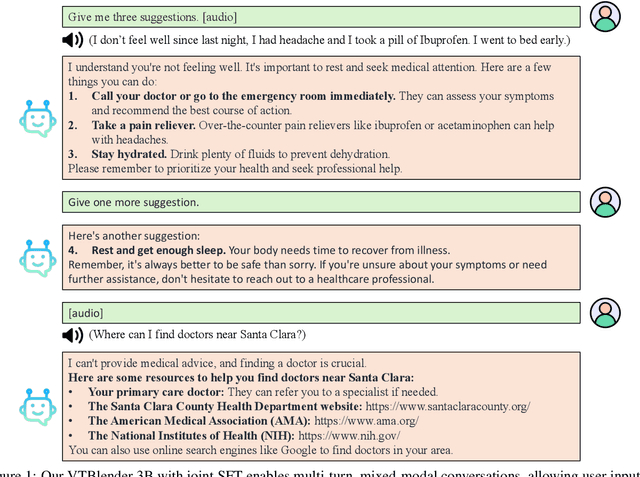
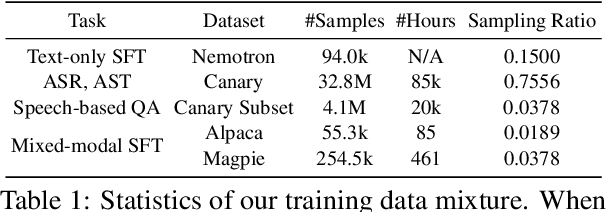
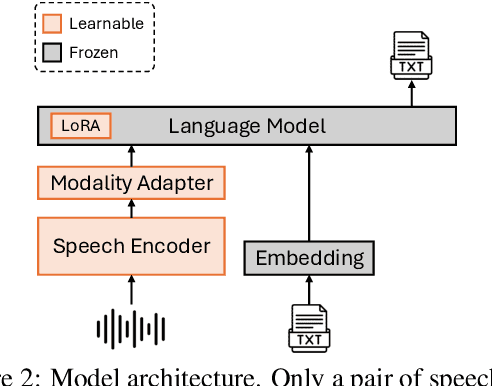
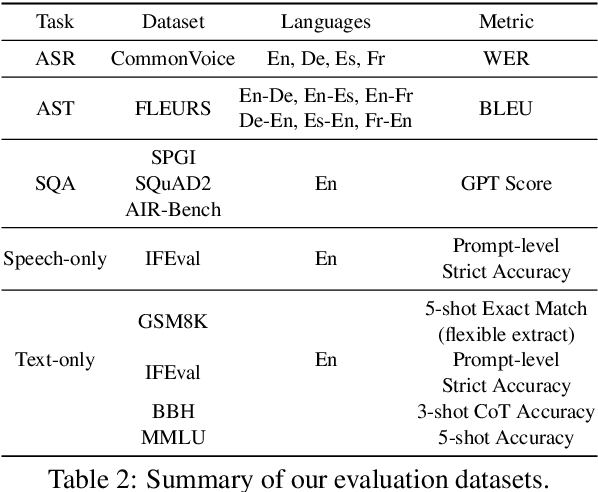
Abstract:Recent studies have augmented large language models (LLMs) with speech capabilities, leading to the development of speech language models (SpeechLMs). Earlier SpeechLMs focused on single-turn speech-based question answering (QA), where user input comprised a speech context and a text question. More recent studies have extended this to multi-turn conversations, though they often require complex, multi-stage supervised fine-tuning (SFT) with diverse data. Another critical challenge with SpeechLMs is catastrophic forgetting-where models optimized for speech tasks suffer significant degradation in text-only performance. To mitigate these issues, we propose a novel single-stage joint speech-text SFT approach on the low-rank adaptation (LoRA) of the LLM backbone. Our joint SFT combines text-only SFT data with three types of speech-related data: speech recognition and translation, speech-based QA, and mixed-modal SFT. Compared to previous SpeechLMs with 7B or 13B parameters, our 3B model demonstrates superior performance across various speech benchmarks while preserving the original capabilities on text-only tasks. Furthermore, our model shows emergent abilities of effectively handling previously unseen prompts and tasks, including multi-turn, mixed-modal inputs.
Developing Instruction-Following Speech Language Model Without Speech Instruction-Tuning Data
Sep 30, 2024
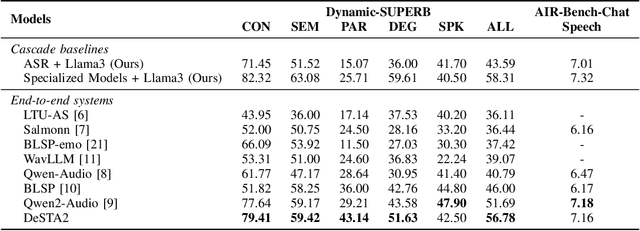
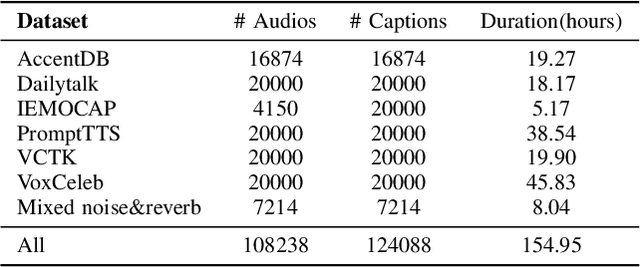
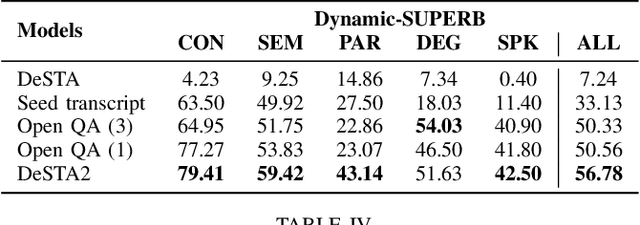
Abstract:Recent end-to-end speech language models (SLMs) have expanded upon the capabilities of large language models (LLMs) by incorporating pre-trained speech models. However, these SLMs often undergo extensive speech instruction-tuning to bridge the gap between speech and text modalities. This requires significant annotation efforts and risks catastrophic forgetting of the original language capabilities. In this work, we present a simple yet effective automatic process for creating speech-text pair data that carefully injects speech paralinguistic understanding abilities into SLMs while preserving the inherent language capabilities of the text-based LLM. Our model demonstrates general capabilities for speech-related tasks without the need for speech instruction-tuning data, achieving impressive performance on Dynamic-SUPERB and AIR-Bench-Chat benchmarks. Furthermore, our model exhibits the ability to follow complex instructions derived from LLMs, such as specific output formatting and chain-of-thought reasoning. Our approach not only enhances the versatility and effectiveness of SLMs but also reduces reliance on extensive annotated datasets, paving the way for more efficient and capable speech understanding systems.
 Add to Chrome
Add to Chrome Add to Firefox
Add to Firefox Add to Edge
Add to Edge